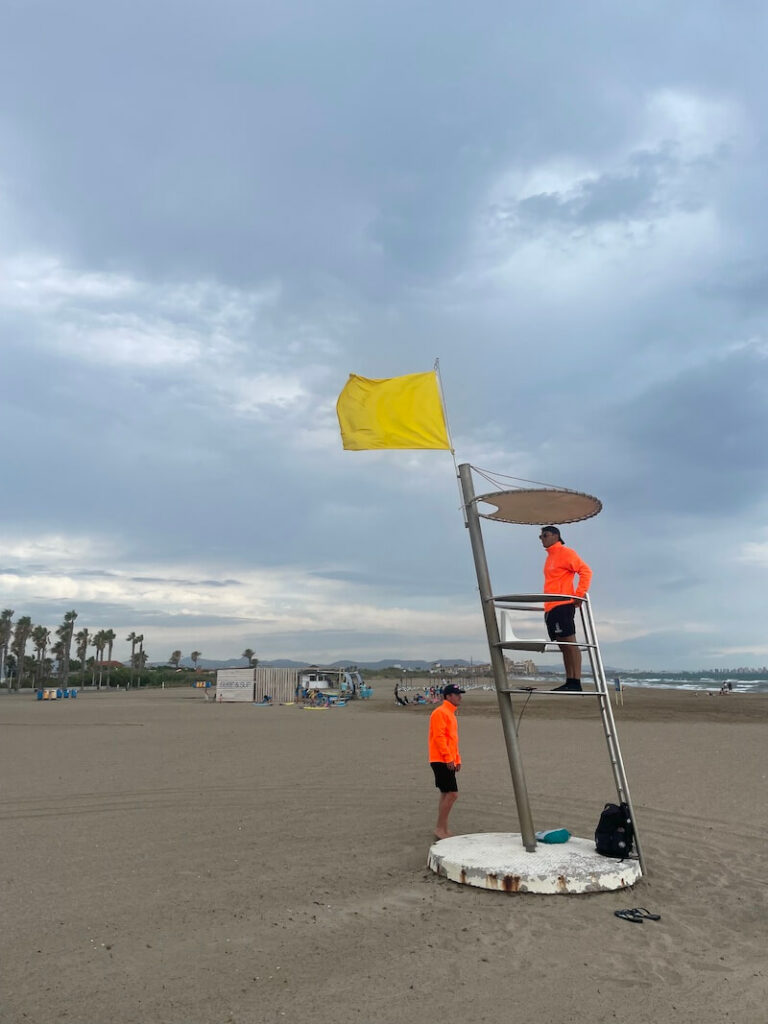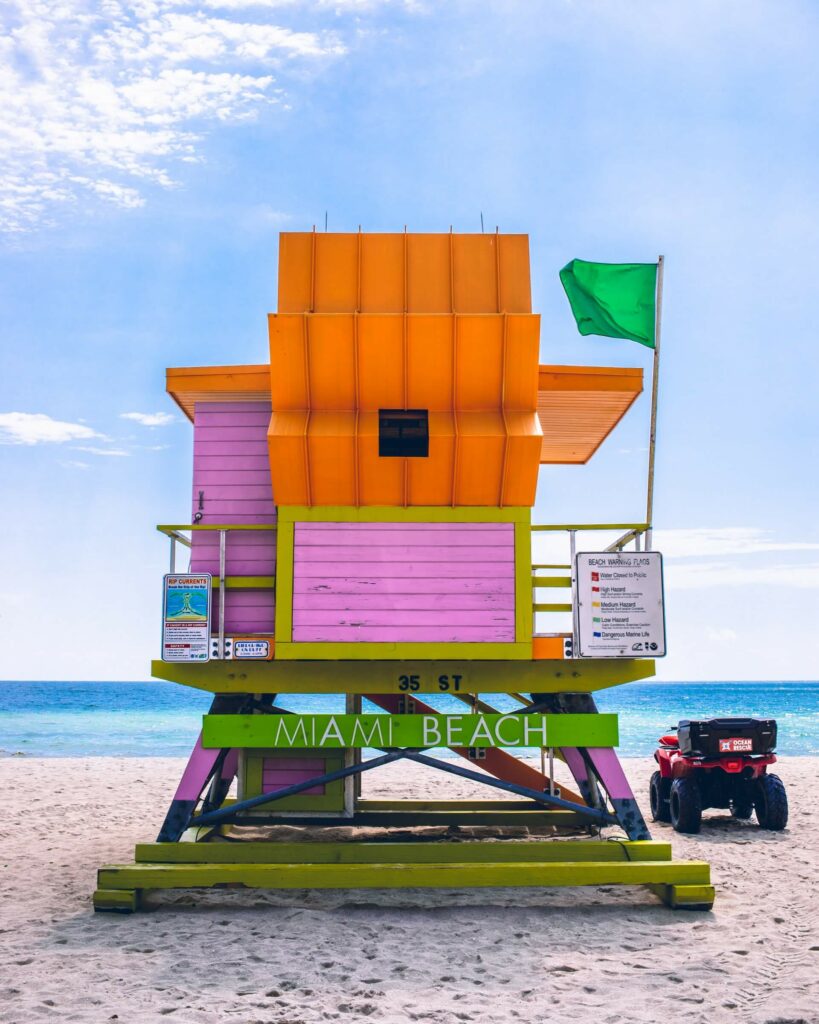The Meaning of Beach Flag Colors
Written by Nadia Podrabinek
Hello, my name is Nadia. I usually write about traveling (there are so many places to fit all the lifestyles), relocation, and living in a foreign country (adapting to a different culture). My travels stretch beyond Spain, with journeys to the US, Italy, Norway, Portugal, and France. Relocating to Spain in 2018, I lived in cities from Barcelona to Madrid, currently calling Valencia home. Follow me on Twitter, Facebook, Instagram, or LinkedIn! ... show more
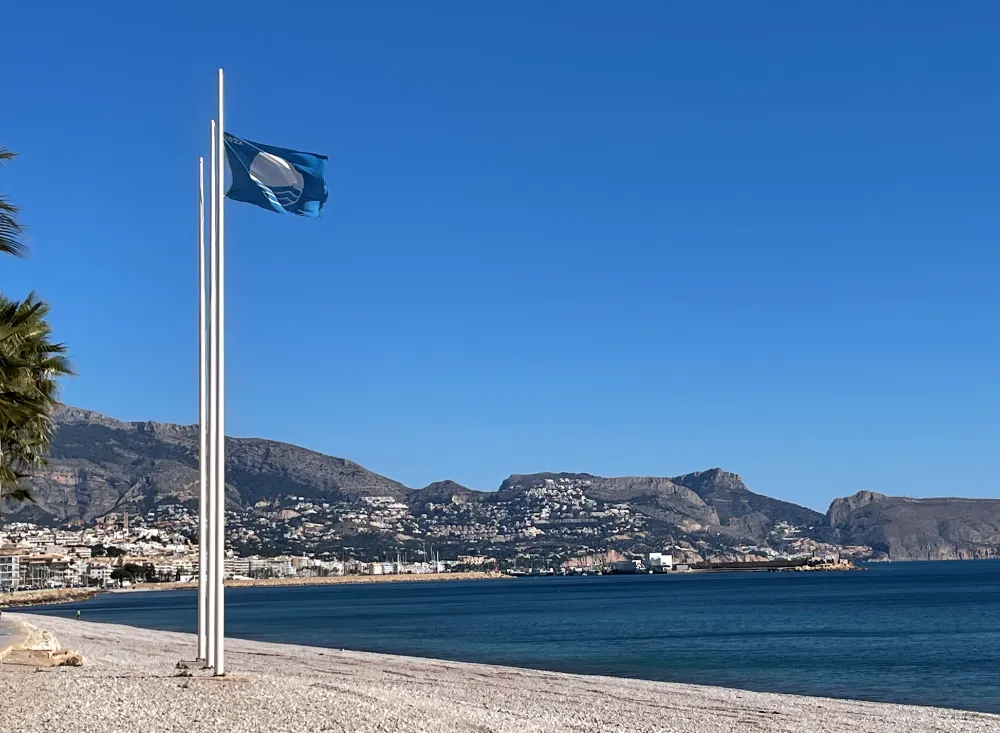
Today, I’m diving into the world of beach flag colors and unraveling the riddles they hold.
As you venture to sandy shores and pristine coastlines, you may have noticed a colorful array of flags fluttering in the breeze. They might appear as a mere decorative touch, but these flags actually serve as essential guides to help you navigate the ocean’s capricious temperament.
So, before you dip your toes into the surf or ride the rolling waves, join me as I explore the language of beach flag colors, and learn how to decode their meanings for a safer and more enjoyable seaside experience. 🏖️🚩
Let’s start with the most surprising one, the blue beach flag. The main thing about the blue beach flag – it’s not a warning flag.
The blue flag is an international symbol for beaches that meet certain standards for safety, cleanliness, and environmental awareness. These standards are set by the Foundation for Environmental Education (FEE), and beaches that meet the criteria are allowed to drop the blue flag.
In other words, the blue flag is a certificate of the environmental quality of the beach. It may seem like a marketing feature at first glance, but there are many tests and criteria the seashore area has to pass to obtain this mark and none of these beaches make money of their visitors.
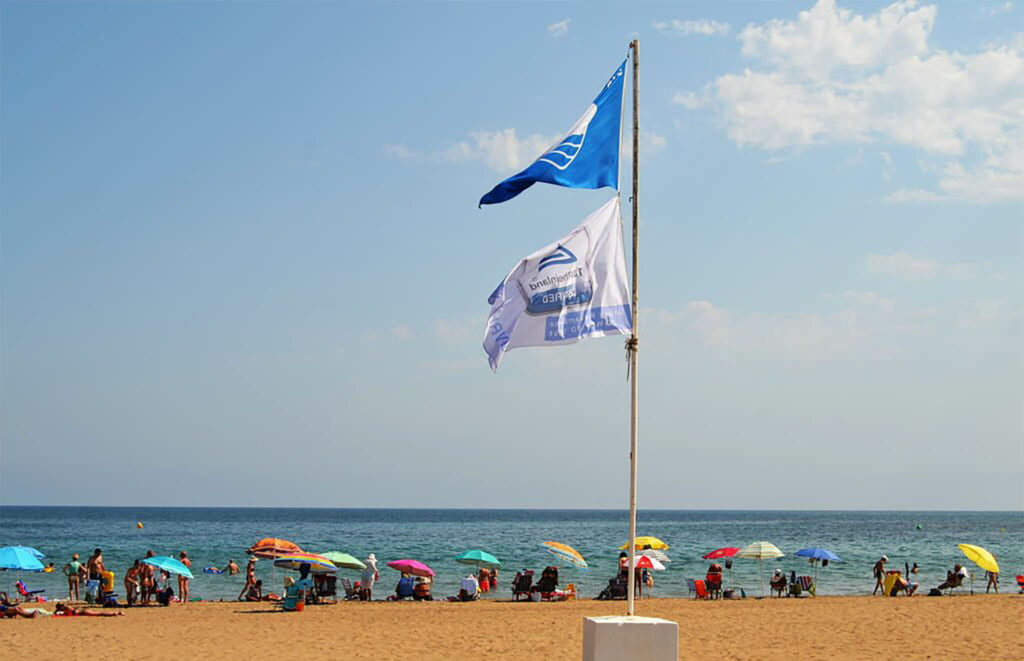
What does a blue flag mean at the beach?
The beach or marina must pass 32 certain tests to have a Blue Flag. Here is the example of some of these criteria:
- display information on water quality, map of beach and its facilities, beach rules or code of conduct,
- comply with water quality sampling,
- stand away from any industrial, urban wastewater, or sewage-related discharges,
- adhere to the beach operator requirements and the local laws,
- the beach must be clean,
- algal vegetation or natural debris must be left on the beach,
- the beach has to have waste bins or containers with separation, restrooms or toilets with controlled sewage,
- no unauthorized camping or driving on the beach,
- access to the beach with the dogs and other domestic animals must be strictly controlled,
- The public must have access to Blue Flag beaches without being a client of a specific hotel or beach club. Access to the beach should preferably be free, although public access is provided at some beaches by charging a small and reasonable fee (no more than 30 US dollars).
The Blue beach flag program has been run since 1987 by a non-profitable organization, the Foundation for Environmental Education (FEE), and now includes over 5,000 certified beaches and marinas across 48 countries.
Okay, now what about the other flags?
If you always forget the beach flag meaning, read the following guide and take a screenshot of the infographics.
The complete list of all beach flags
The main thing about beach flags is that you must take them seriously. The good thing is that the color coding is the same across the world, so there’s not too much to remember.
| Flag Color | Symbol | Beach Flag Meaning |
| Red | Solid | High Hazard: Dangerous water conditions, such as high waves and strong currents. No swimming is allowed. |
| Yellow | Solid | Medium Hazard: Moderate surf and currents. Caution should be exercised when entering the water. |
| Green | Solid | Low Hazard: Calm conditions, little or no surf or current. Swimmers should still exercise caution. |
| Purple | Solid | Dangerous Marine Life: Presence of jellyfish, stingrays or other hazardous marine life. |
| White+Black | Quartered | Surfing Area: Designates an area reserved for surfing, and swimming is not allowed. |
| Blue | Solid with White Star | Accessible Beach: Designates an area that is accessible to people with disabilities. |
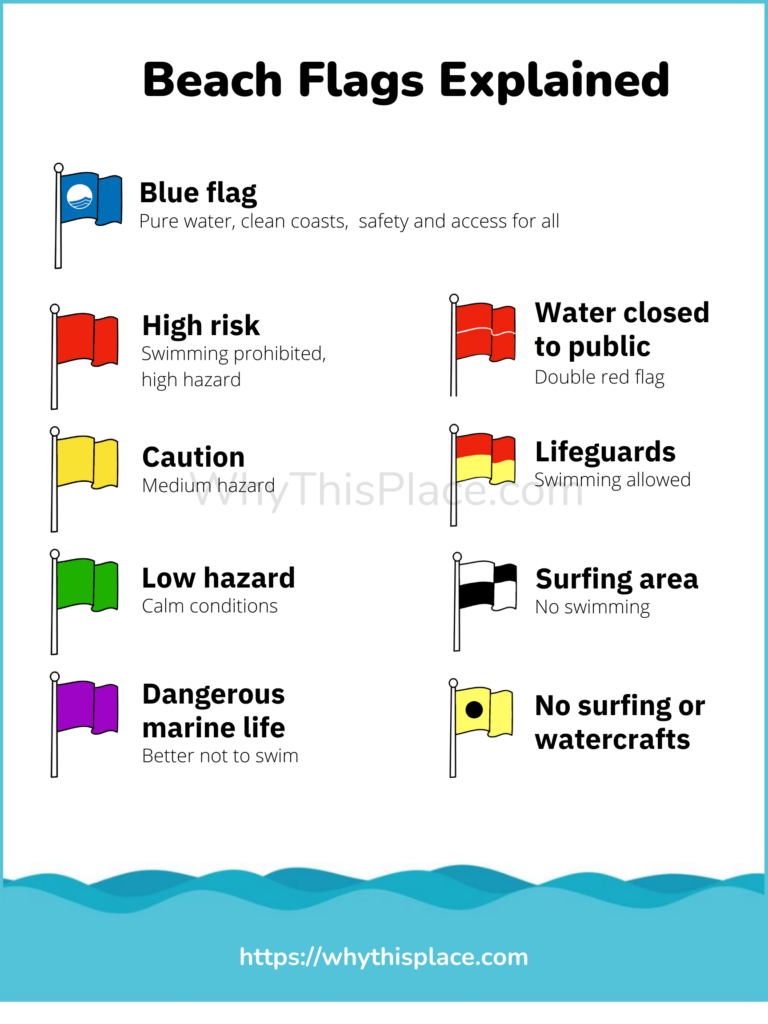
Red beach flags mean that you have surf and swimming conditions high enough to drive deadly rip currents (the currents that flow away from the shore). Anytime currents pull into the sea, the red flag appears on the beach.
You can watch the example of a strong tide current in this video:
The yellow beach flag is a moderate hazard. When beach administration finds rips aren’t pulling much into the sea, they drop a yellow flag.
The green beach flag is a minimal hazard, and the minimal hazard still means that there are some dangers out there. If the tide is dropping, regardless of whether the water is flat or the tide comes in—that is current, and it will drive you.
The purple beach flag means hazardous marine life, and they usually drop it for jellyfish or stingrays in the water. Both jellyfish and stingrays pose a hazard to walking. So, take care if you’re swimming in the water or even if you’re walking on the sand.
The quartered black and white beach flag indicates a waterfront area for surfboats, paddle boats, and other non-powered watercraft.
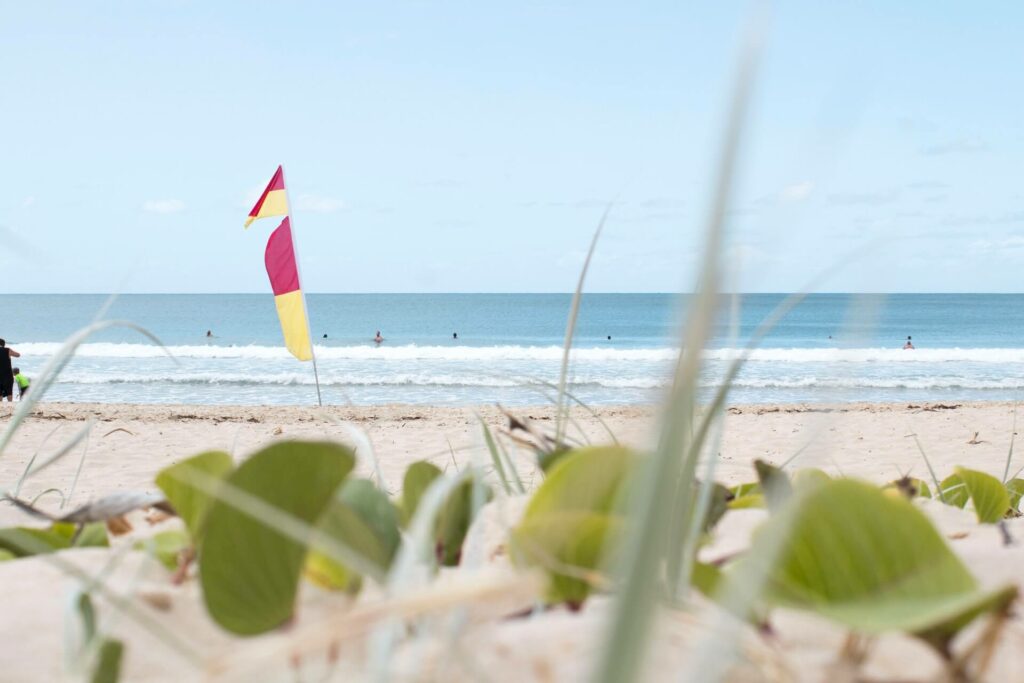
The red and yellow beach flag means the lifeguards are watching the shore. Swimming is allowed in the area.
The yellow beach flag with a black circle indicates that the swimming area is not for surfers and people with other watercraft.
Can I swim if there is a purple flag on the beach?
Yes, but at your own risk. There are many types of jellyfish, including some nasty ones (e.g., Box Jellyfish), and I’d probably talk to the lifeguard before swimming under purple flag conditions.
What does a double red flag mean?

You cannot get in the water whenever there’s a double red flag – the waters are closed to the public. There may be an exception for surfers on some beaches when surfers are attached to the leash.
Rip Currents
Rip currents are powerful, narrow channels of fast-moving water that can drag you away from the shore. They pose a significant danger due to several factors:
- Speed: Rip currents can move up to 8 feet per second (2.4 m/s), which is faster than an Olympic swimmer. This makes it challenging for even the most experienced swimmers to escape them.
- Unpredictability: Rip currents can form suddenly and at any beach with breaking waves, making them difficult to predict. They are also not easily visible from the shore or the water surface, making it hard to identify and avoid them.
- Exhaustion: Swimmers often panic and attempt to swim directly against the rip current, quickly leading to fatigue and increasing the risk of drowning.
If you find yourself caught in a rip current, remember these essential tips to increase your chances of escaping safely:
- Stay calm: Panicking can lead to exhaustion and poor decision-making. Conserve your energy and take a moment to assess the situation.
- Float: Rather than fighting the current, try to float or tread water. The rip current will not pull you underwater; it will just carry you away from the shore.
- Swim parallel to the shore (This is the main rule, to be honest!): Instead of swimming directly against the current, swim parallel to the beach until you’re out of the rip current’s grip. Once you’ve escaped the current, swim back to shore at an angle.
- Signal for help: If you can’t swim out of the rip current, draw attention to yourself by waving your arms and shouting for help.
Always pay attention to beach flags and posted signs to stay informed about the presence of rip currents or other hazards.
Additionally, swimming near a lifeguard and learning about local water conditions before venturing into the ocean is a good idea.
Beach Flag Meanings FAQ
The absence of flags doesn’t mean safe waters. The sea or the ocean is no joke, be reasonable with your choices.
According to the FEE reports, Spain is the country with most blue flag beaches across the world. There are more than 600 blue flag beaches and over 100 blue flag marinas in Spain.
There is no specific beach flag for sharks; therefore, the double red flag will be set at the beach area.
No. Beach flag meanings in Florida follow the same general guidelines as those used in many other parts of the world. The flag system in Florida typically consists of four colors: Green, Yellow, Red, and Purple (This flag is usually flown along with another colored flag).
Only at your own risk. The water is considered dangerous for all swimmers, and it’s best that you stay out of the water. There can also be two red flags flown side by side, which signals that the beach is closed to the public due to extremely hazardous conditions.

